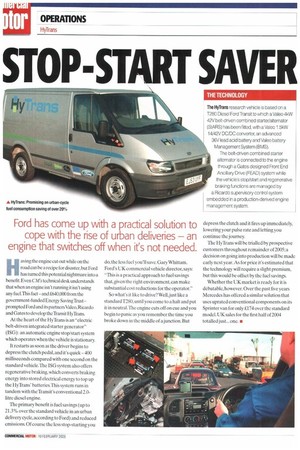STOP-START SAVER
Page 54

If you've noticed an error in this article please click here to report it so we can fix it.
Ford has come up with a practical solution to cope with the rise of urban deliveries — an engine that switches off when Ws not needed.
Having the engine cut out while on the road can he a recipe for disaster,but Ford has turned this potential nightmare into a benefit. Even CM 's technical desk understands that when an engine isn't running it isn't using any fuel.This fact -and £640,000 from the government-funded Energy SavingTrust prompted Ford and its partners Valeo,Ricardo and Gates to develop the Transit HyTrans.
At the heart of the HyTrans is an -electric belt-driven integrated starter generator" (ISG): an automatic engine stop/start system which operates when the vehicle is stationary.
It restarts as soon as the driver begins to depress the clutch pedal, and it's quick -400 milliseconds compared with one second on the standard vehicle.The ISG system also offers regenerative braking, which converts braking energy into stored electrical energy to top up the HyTrans' batteries, This system runs in tandem with the Transit's conventional 2.0litre diesel engine.
The primary benefit is fuel savings (up to 21.3% over the standard vehicle in an urban delivery cycle, according to Ford) and reduced emissions. Of course the less stop-starting you do, the less fuel you'll save. Gary Whittam, Ford's UK commercial vehicle director, says: "This is a practical approach to fuel savings that, given the right environment, can make substantial cost reductions for the operator."
So what's it like to drive? Well,just like a standard T280, until you come to a halt and put it in neutral, The engine cuts off on cue and you begin to panic as you remember the time you broke down in the middle of a junction. But depress the clutch and it fires up immediately, lowering your pulse rate and letting you continue the journey.
The HyTrans will be trialled by prospective customers throughout remainder of 2005; a decision on going into production will be made early next year. As for price it's estimated that the technology will require a slight premium, but this would be offset by the fuel savings.
Whether the UK market is ready for it is debatable, however. Over the past five years Mercedes has offered a similar solution that uses uprated conventional components on its Sprinter van for only £174 over the standard model. UK sales for the first half of 2004 totalled just... one. •






































































































































































































